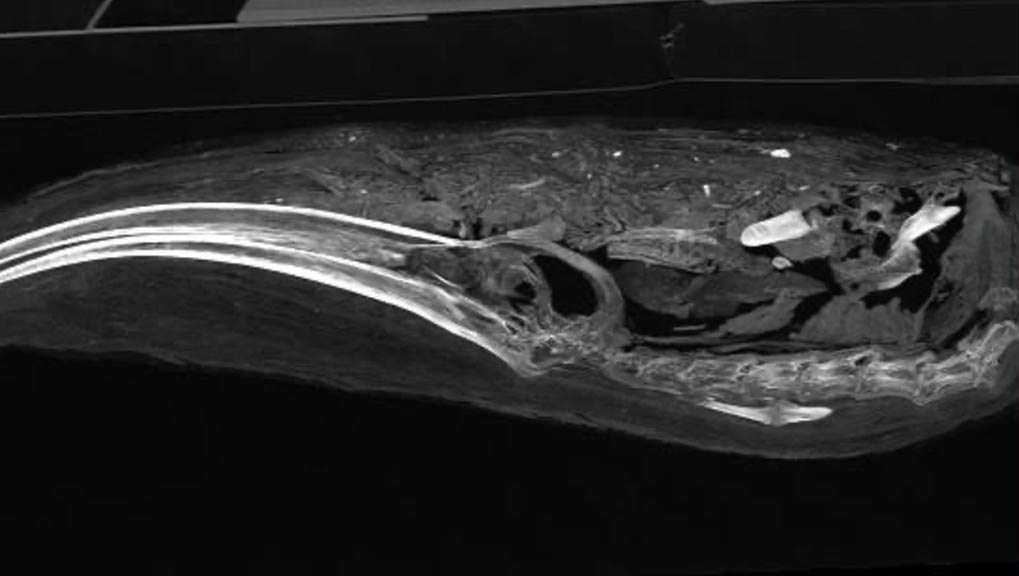
From the Summer 2022 issue of Living Bird magazine. Subscribe now.
Over the last several months, a certain bird, believed to be an African Sacred Ibis, has been drawing a lot of attention and covering a lot of ground at Cornell University—from the College of Arts and Sciences to the College of Veterinary Medicine, College of Engineering, and the Cornell Lab of Ornithology.
Not bad for an animal that has been dead and mummified for more than 1,500 years.
The so-called “mummy bird” has had help getting around. Carol Anne Barsody, a master’s student in archaeology, has been involved in several different aspects of research that took the bird to various places on campus as she tried to learn everything she could about the artifact—part of the Cornell University Anthropology Collections.
“One of the things I love about this project is that it incorporates expertise from across Cornell, all working together on a common goal,” Barsody said.
The mummy bird’s exact provenance is difficult to determine. Ever since the late 1800s, mummies of different shapes and sizes and species have found their way to Cornell. Its physical appearance —a tear-shaped swaddle of linen, barely larger than a football—reveals very little, and no record exists of the mummy’s arrival at the university, probably a century or more ago. Since then, it has moved among various university collections, stored inside a box mislabeled “hawk mummy.”
Barsody herself found a unique route to the project. She first came to the university not as a student, but as an employee, with a background in mathematics, working for the Center for Technology Licensing. Then she entered the university’s employee degree program and received full tuition to pursue a master’s degree in archaeology.
Her primary research interest is the ways technology can be integrated within museum exhibitions and how that might change museum collecting practices, access to collections, and help with repatriation efforts. The mummy bird made for an effective case study. So Barsody set out to find collaborators who could use 21st-century technology to help her peek under the mummy’s wrappings without disturbing the integrity of the artifact.

In November, Barsody and Frederic Gleach, curator of the Cornell Anthropology Collections, brought the mummy to the Cornell College of Veterinary Medicine, where an imaging technician conducted radiographs and a CT scan that confirmed their bundle did in fact contain a bird. Not only that: The CT scan showed that some of the bird’s soft tissue and feathers were still intact.
Hoping to learn more about their bird’s biological and physiological characteristics, Barsody and Gleach took the mummy to Vanya Rohwer, curator of the Cornell Museum of Vertebrates, which is housed at the Cornell Lab of Ornithology.

After reviewing the scans and consulting a database, Rohwer identified the bird as a male African Sacred Ibis, on account of its overall body shape and downward sloping bill. This wasn’t a total surprise, Barsody said, since ibises were commonly mummified due to their association with death and Thoth, the god of wisdom and magic. Ibises were so popular, they were sometimes bred en masse for the sole purpose of being sold as votives. According to Birds of the World, 1.5 million ibises were entombed in catacombs at Saqqara, the site of a vast necropolis and pyramids at the ancient Egyptian capital of Memphis. Sacred ibises were common in Egypt until the early 19th century, but they were almost completely gone by 1850 and are extirpated from the country today.
Rohwer weighed the mummy, which came in at 942 grams, roughly the same as a quart of milk. As best they can tell, the bird is somewhere on the order of 1,500 to 2,000 years old.
“It’s fun to piece these things together,” Rohwer said. “It’s a real-life puzzle.”
The most significant piece of that puzzle may turn out to be the soft tissue the CT scan revealed. Barsody is now back at the College of Veterinary Medicine, consulting with Dr. Eric Ledbetter, professor and section chief of ophthalmology, about the prospect of extracting genetic material through endoscopic microsurgery. If the bird’s DNA matches any other samples from a database of mummified sacred ibises, Barsody should be able to determine the temple where it was buried, and thus the age and the region in which it lived.
The next phase of Barsody’s project is even more ambitious.
“I want to bring the bird back to life,” she said.
Barsody is working with Cornell electrical and computer engineering undergraduate student Jack Defay to scan the mummy with open-source technology and smartphones in order to build a 3D model of the bird—a low-cost method of artifact digitization. The mummy bird, its 3D model, and a hologram version will all be included in a multisensory exhibition that Barsody is planning to hold at Upson Hall on the Cornell campus in October.
“The goal is to gauge the public’s readiness for exhibitions without the artifacts,” said Barsody, who currently works at Cornell’s Johnson Museum of Art. “That gets into bigger questions about repatriation, institutional collecting practices, access, and education in this post-COVID world, where you might not be able to actually get to a museum.”
All the while, she continues to dig through university archives and historical records to learn as much as she can about the mummy and what it meant to a culture that thought so highly of this bird, they preserved it forever.
“Not only was this once a living creature that people of the day may have enjoyed watching stroll through the water. It also was, and is, something sacred, something religious,” Barsody said. “Now it has this whole entire life of being studied, and respected, as a small representative of the amazing culture from which it originated. It’s had multiple lives.
“I look at what I’m doing as another form of extending its incredible life.”

